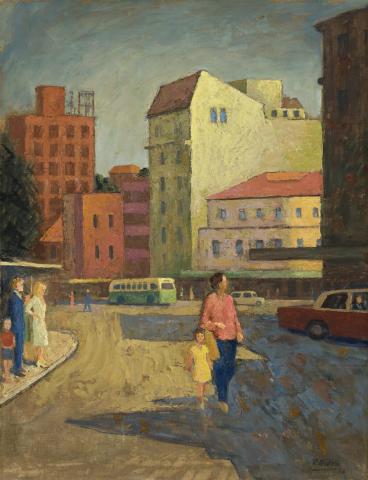MANLY, 1964
ROLAND WAKELIN
oil on canvas on board
102.0 x 86.5 cm
signed and dated lower right: R. Wakelin /'64
Private collection, Melbourne
Society of Artists Annual Exhibition, Art Gallery, Department of Education, Sydney, 30 October – 13 November 1964, cat. 30 (as'Manly Scene')
Roland Wakelin: Master of Colour, Newcastle Region Art Gallery, New South Wales, 18 January – 9 March 2003, and touring to Macquarie Art Gallery and Muswellbrook Regional Art Gallery, New South Wales, May – December 2003
Roland Wakelin: Master of Colour, Newcastle Region Art Gallery, New South Wales, 2003, pp. 40, 55, cat. 29 (illus.)
Throughout his long creative life, Roland Wakelin loved to paint Sydney, its busy harbour and surrounding suburbs, Manly, 1964 being a particularly interesting example. The scene was set early by three major paintings, The Fruit Seller of Farm Cove, 1915 (National Gallery of Australia, Canberra), Down the Hills to Berry's Bay, 1916 (Art Gallery of New South Wales, Sydney), and Boat Sheds, 1918 (Newcastle Region Art Gallery, New South Wales), in which he explored Post-Impressionist concepts of form and colour. Even his brilliant experiments with Roy de Maistre on the relationship of colour and music were based on Sydney subjects. There was a brief period when he fell under the influence of Max Meldrum's tonalism, but form and colour were his chief interests. Wakelin did not limit himself to Sydney, exploring the rich coastal scenery at Terrigal, the geometric forms of the old convict bridge at Richmond in Tasmania, or Melbourne's city skyline from across the Yarra; but it was Sydney that inspired him most " its buildings, people and absorbing landscape. As with many artists of his time, the Harbour Bridge featured in landscapes of the thirties. The stately buildings of Sydney University, the Showground Tower, and the modernist, glass-fronted Qantas House all attracted his brush, invariably peopled with Sydneysiders going about their various activities.
Manly, 1964 has a two-fold interest for today's collector. First, it provides an historic view of Manly in the sixties, looking from the East Esplanade of Manly Beach across to the West Esplanade. The Hotel Manly is no longer standing, the style of the time being captured in the clothing the people wear, the big, flash car, and in the yellow-green of the Sydney bus. Manly is, of course, one of Australia's most popular surf beaches. The first World Surfboard Titles were held there in 1964, the same year this work was painted. Secondly, there are the formal interests and aesthetic appeal of the painting, of form analysed and built up in rich reds, pinks, yellows and blues. As in the central figure group, the focal point of the painting, Wakelin begins with the observed mother and child, and transforms them into a harmony of primary colours. It is by such gifted means that Wakelin translates a transcript of the everyday into an engaging work of art, for he was essentially a formalist, concerned with the structure of his paintings, the monumentality of the buildings in this painting being achieved by investing them with a masterly feeling of volume and weight. Manly received its name from Captain Arthur Phillip of the First Fleet, taken from his reference to the'manly behaviour' of its indigenous people. This apt description lived on, as seen in Wakelin's view of the sixties.
DAVID THOMAS
